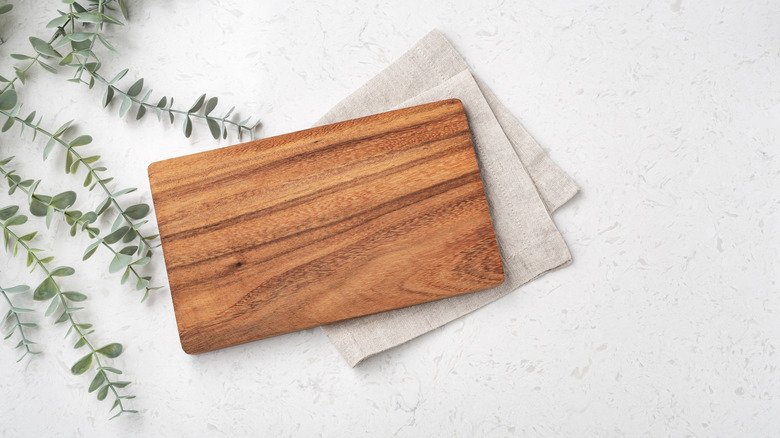Michael Symon Is Educating Twitter On Plastic Cutting Boards
There's a lot to consider when it comes to cutting boards and food safety in the kitchen, whether it be a professional kitchen at a busy restaurant or a small residential kitchen in an apartment. According to Michigan State University, the biggest food safety issue to be aware of when it comes to cutting boards is cross-contamination. Regardless of what material the cutting board is made of, it's important to assign cutting boards to individual tasks, such as one board for cutting raw meat and one board for cutting vegetables or bread, to prevent foodborne illness.
Regarding cutting boards and food safety, chef and restaurateur Michael Symon shared his thoughts and advice on Twitter, with one fan asking Symon for some information on the differences between cutting boards made of plastic and wood. The chef replied, "They are horrible[.] [Plastic cutting boards] harbor bacteria [and are] bad for knives[.] [They are] just awful[.] [W]ood is way safer[.] [There's] tons of research on line [sic] to prove [that] wood actually naturally kills bacteria." This may come as a surprise to people who swear by plastic cutting boards, but there is some truth behind what Symon said. Two microbiologists from the University of Wisconsin named Dean Cliver and Nese Ak did a study where they compared wooden and plastic cutting boards to see which one was safer in terms of food safety and bacteria, according to The New York Times. The chef elaborated on his stance when users asked him for more tips.
Michael Symon recommends wooden cutting boards over plastic
When two microbiologists covered wooden and plastic cutting boards with various bacterium, including Salmonella, E. coli, and Listeria, they found that bacteria on the wooden boards died after three minutes, whereas the bacteria on plastic boards survived indefinitely, per The New York Times. They also found that cutting boards made of plastic were able to be sanitized a lot easier than wood because plastic is more nonporous than wood; however, it's also a lot easier to create cuts, grooves, and gashes in a plastic cutting board than a wooden one, per North Carolina State University. Furthermore, while wood may be a bit more difficult to thoroughly sanitize, it's a lot harder to create those same crevices that bacteria love to hide and multiply in.
Another Twitter user asked how they should clean wooden cutting boards, and Michael Symon explained that all you really need is soap and water, making sure to thoroughly rinse the wooden board and "dry it on its side." Symon also says that you can use salt and lemon juice to clean wooden boards and suggests oiling the boards from time to time. According to the United States Department of Agriculture's (USDA) Food Safety and Inspection Service, both wooden and plastic cutting boards can also be cleaned by using a mixture of unscented liquid bleach and water. Once the cutting board has severe cuts and gashes, it's best to throw it away and get a new one.

